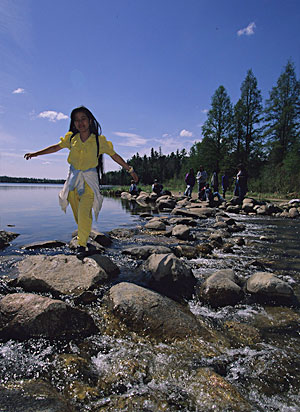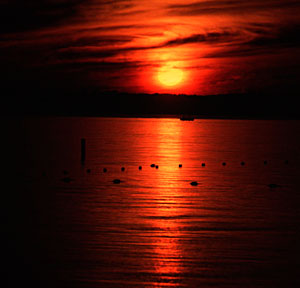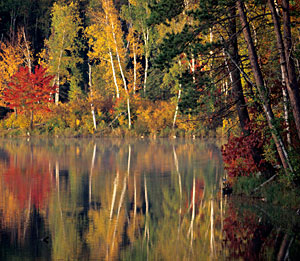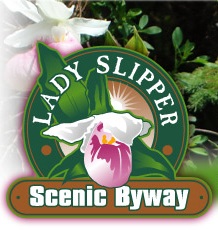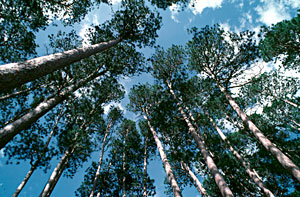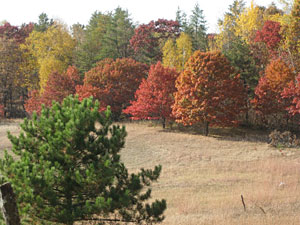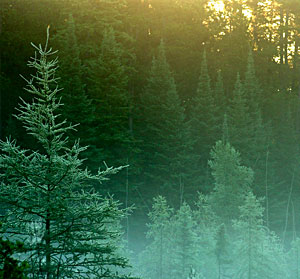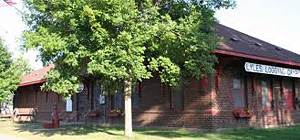Itasca State Park
Itasca State Park is the oldest and most popular park in Minnesota and is only a 45-minute drive from your vacation spot in the Cass Lake area. In the summer, you’ll find the headwaters of the Mississippi River, 6,000 acres of old-growth pines, including the largest red pine and the largest white pine in the state, and miles of hiking and biking trails. In the winter, Itasca offers miles of groomed trails for cross-country skiing and snowshoeing.
Facilities at the park include the Headwaters History Center, Douglas Lodge and Museum, Gift Shop, and bike and boat rental outlets. Activities include weekly naturalist programs during the summer months, guided boat tours on Lake Itasca, the annual Ozawindib Walk (5K or 10K), the Headwaters 100 Bike Ride/Race, and a variety of daily events.
Entrance to the park is 21 miles north of Park rapids on U.S. Highway 71. From Bemidji, the park is 30 miles south on US Hwy 71.
A state park sticker or daily permit is required. Learn more by visiting their official website.
Lake Bemidji State Park
This park is the perfect playground any time of year, offering visitors swimming, birdwatching, hiking, camping, biking, picnicking, snowmobiling, cross-country skiing and year-round naturalist-led activities. Hikers can explore the beauty of a tamarack bog carpeted with showy lady's slippers, pitcher plants, dragon's mouth, grass pink, and insect-eating sundews. Most flowers are blooming in the bog during late spring and early summer.
The unique boardwalk into the quiet, mysterious world of a spruce-tamarack bog offers visitors a rare chance to view orchids, mosses and insect eating plants. Swimming, fishing for walleye on Lake Bemidji; 14 miles of hiking, 5 miles of biking, 9 miles of skiing and snowshoeing are visitor favorites in this popular vacation spot.
A state park sticker or daily permit is required. Learn more by visiting their official website.
Lake Bemidji State Park
Take a step into the past during your MN vacation with a visit to historic Camp Rabideau. The camp is located 6 miles south of Blackduck, Minnesota on County Road 39. In the 1930s, there were 2,650 Civilian Conservation Corps (CCC) camps in America. Camp Rabideau is one of three remaining camps and has been preserved, having been placed on the National Register of Historic Places in 1976.
A one-mile trail runs through Camp Rabideau. Interpretive displays highlight the buildings and history of the area. For those wishing to camp, Webster Lake Campground is located four miles southeast of Camp Rabideau off forest Roads 2207 and 2236. The campground offers 22 campsites, a boat ramp, a 6-mile hiking trail, two picnic areas and a barrier-free campsite.
Learn more by visiting the U.S. Forest Service's Camp Rabideau page.
Lady Slipper Scenic Byway
Lady Slipper Scenic Byway goes “over the river and through the woods,” just like the song says. The river is the Mississippi River, where it passes out of Cass Lake as a wilderness stream, close to the beginning of its long journey. The woods are the pines, aspen and birches of the Chippewa National Forest, which covers a wide expanse of north central Minnesota. This rustic route is one of the 22 Minnesota Scenic Byways, and the perfect destination during your summer stay at one of the Minnesota Northwoods vacation spot.
Lady Slipper Scenic Byway official website.
Big Bog State Recreational Area
Big Bog includes a northern unit and a southern unit. The 500-square-mile peat bog is the largest peat bog in the lower 48 states and is located in the northern unit. Also in the northern unit is a mile-long boardwalk that allows visitors to enjoy the unique plants and animals of the area. Yellow-eyed grass, bog rush, and two varieties of sundews, all on Minnesota's endangered or threatened species list, are located in Big Bog State Recreation Area. Visitors are able to enjoy these rare plants and flowers along with a large variety of rare birds.
The southern unit is home to a campground, sandy beach, picnic grounds, and great fishing.
Learn more by visiting the Minnesota DNR's Big Bog page.
The Lost Forty
Experience the forest of old at the Chippewa National Forest's "Lost Forty." The original Government Land Survey in 1882 described the land of the Lost Forty as part of Coddington Lake. This mapping error caused the virgin pine of the area to be left behind by loggers at the turn of the century. The Lost Forty is actually 144 acres.
Directions
- From Blackduck, take County Roads 30/13 to Alvwood (about 13 miles)
- Travel north on State Highway 46 for 1/2 mile to County 29
- Follow 29 east for about 11 miles to Dora Lake and County 26
- Travel 2 miles north on 267 to Forest Road 2240
- About 1 1/2 miles west of this intersection you will find a sign for the Lost Forty
Facilities
A one-mile self-guided trail winds its way through the majestic pines of the Lost Forty.
Carry-in boat access is located on the north side of Coddington Lake. The lake offers northern pike fishing, mallard and wood duck hunting and wild ricing.
Learn more by visiting the U.S. Forest Service's Lost Forty page.
Management
Most of the mature red and white pine is found on the east end of the Lost Forty. These trees are up to 350 years old and between 22 and 48 inches in diameter. In other areas of the Forest, white pine is managed for pulp (paper), lumber, wildlife and aesthetics, and the trees are harvested at about 80 to 150 years. Biologically, pine can live up to 500 years. Most of the aspen growing in the area is about 60 years old and is beginning to deteriorate. Aspen reach its biological old age at about 85 years. Old growth such as the Lost Forty is valuable for wildlife, including bald eagles, a number of hawks and woodpeckers, red squirrels, weasels and numerous other species.
The Lost Forty is considered a unique area in the Chippewa National Forest and will be managed to maintain its old growth character.
Chippewa National Forest
The vacation spots surrounding Cass Lake, Blackduck, and Bemidji are far-removed from everyday traffic and noise. Our uniquely remote location and proximity to the heart of the Northwest Chippewa National Forest provides an abundance of wildlife. The pages listed below highlight your opportunities to navigate through our Northwoods nature.
Learn more at: http://www.fs.usda.gov/chippewa
Star Island
One of the unique features of the Cass Lake area is right in the middle of the lake: Star Island, - accessible only by boat, but well worth a visit. Named for its shape by the Chippewa Indians, the island boasts its own lake, Lake Windigo, which is featured in Ripley's "Believe It or Not" as "lake in the island in the lake." The island is both public and private. There are some homes on the island under a lease arrangement with the federal government, but the Forest Service manages the island for scenic and recreation use as well.
A campground has six miles of hiking trials make the island open for all kinds of recreational uses. The island is also part of the Chippewa National Forest's 10-section area, protected since 1902 from timber cutting. Its old growth pine trees make it a favorite with bald eagles. According to a history of the island, Hudson's Bay Co. once had cabins on the northwestern part of the island. Zebulon Pike visited the island in 1806, and in 1832, Henry Schoolcraft came to the island to ask Chippewa leader Yellow Head to lead him to the source of the Mississippi River. The Indian village on the island was reportedly wiped out in the 1890s, when a smallpox epidemic also took a heavy toll on the mainland population. In 1909, the federal government granted the first permit to a private citizen to build a vacation home. Until a few years ago, the island was served by the Postal Service—by boat.
Lyle's Logging Camp
Experience some of Cass Lake's past in the historically accurate museum of logging artifacts. Scaled-down replicas of equipment once used by loggers are on display, and each building is furnished just as it would have been in the early days.
Explore what it was like to be a lumberjack at the logging camp with an audio self-tour or ask Ed Hill to personally escort you for the most wonderful stories of logging as you tour the Wanigan, Bunkhouse, Cookhouse, and Blacksmith shop. Relive the period when white pine was king in the lumbering business. Plan your stay with advice and event information. Open Memorial Weekend through Labor Day 9-4:30 daily. 1-800-356-8615.

